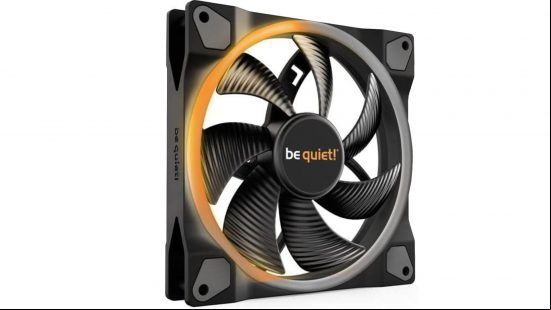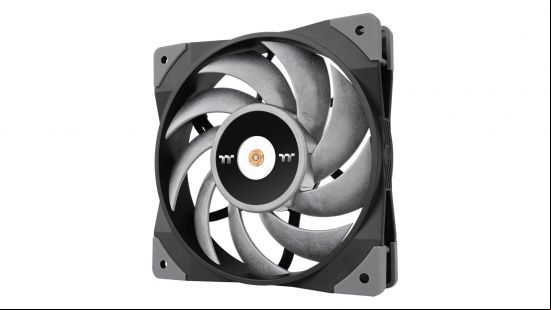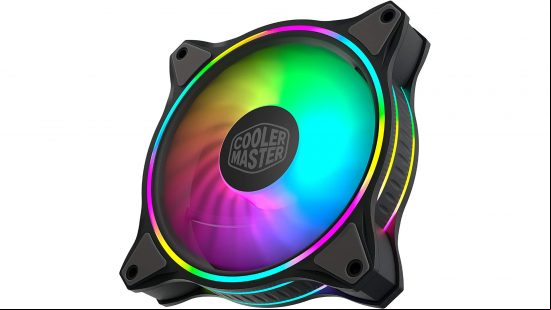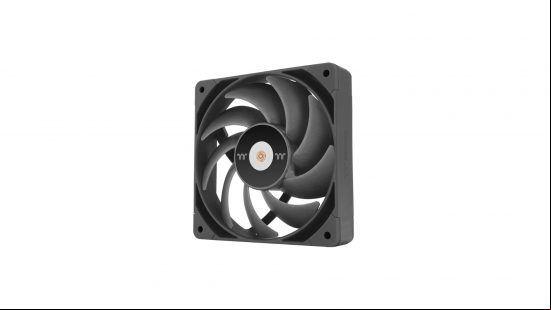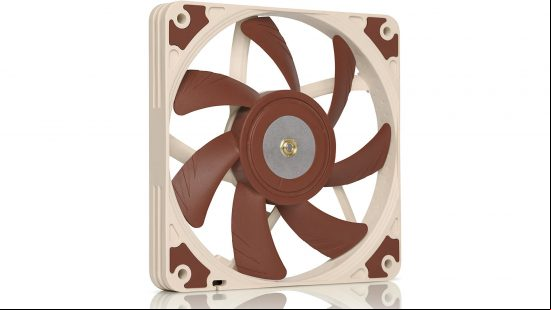What are the best PC fans? Upgrading your PC fans isn't just about adding RGB lighting or for silent PC obsessives. All gaming PCs need good cooling to ensure consistent operation without any crashes or drops in speed. If you're building a new system, many PC cases either ship with no fans or only include a few, so you'll need to buy at least some fans. Whether you're priority is peak performance, quiet operation, all the RGB, or cost, our list has the right fan for you.
The best fan overall is the FAQ section should also answer any other PC fan questions you have.
Why you can trust our advice ✔ At PCGamesN, our experts spend hours testing hardware and reviewing games and VPNs. We share honest, unbiased opinions to help you buy the best. Find out how we test.
Best PC fans:
Noctua NF-S12B redux-1200 PWM
Best PC fan for most
Noctua NF-S12B redux-1200 PWM specifications:
| Sizes |
120mm |
| Airflow (CFM) |
59.2 |
| Speed (RPM) |
400 – 1,200 |
| Noise (dBA at max speed) |
18.1 |
| Connector |
Four-pin PWM (also in three-pin) |
| Lighting |
None |
| Type |
Airflow |
Pros
- Great at cooling components
- Quiet
- Very affordable
Cons
- Color scheme clashes with most builds
- Doesn't manage cables with daisy chaining
You might know Noctua as the company that douses its fans in beige and brown, but this grey blower packs a huge punch for its price. As the perfect embodiment of the 'why not both' meme, the Noctua NF-S12B redux-1200 PWM refuses to compromise between noise and airflow, delivering a whopping 59.2CFM airflow at just 18.1dBA.
It's possible to go even quieter, but the NF-S12B isn't just our favorite overall fan, it's one of the best cheap PC fans. A few decibels sacrificed are worth the cost and it's still the second quietest fan on this list – you can use Noctua's anti-vibration mounts if you want to pull out all the stops.
Noctua is almost entirely function over form as the two-tone color will divide plenty of PC gamers, but there is a solution at the bottom of this list if you want to add RGB and complete the trifecta. Yes, you read that right, you can add RGB to a fan (details on that at the bottom of the list).
be quiet! Light Wings
Best RGB fans
be quiet! Light Wings specifications:
| Sizes |
120mm (140mm also available) |
| Airflow (CFM) |
41.51 |
| Speed (RPM) |
1,700 |
| Noise (dBA at max speed) |
20.6 |
| Connector |
Four-pin PWM |
| Lighting |
18 ARG8 LEDs |
| Type |
Airflow (high-speed static pressure available) |
Pros
- Wonderful RGB lighting
- Good RPM to airflow ratio
Cons
- Pricey
- Not as quiet as Silent Wings
There's no beating around the bush, be quiet! is all about living up to its name and keeping things hush. Fortunately, its first attempt at a splash of color is no exception, as the Light Wings are the quietest RGB fans we've ever used. The ring light itself packs 18 LEDs in the 120mm model and 20 LEDs in the 140mm version, each of which is addressable in your motherboard's software.
You're not stuck for selection, as be quiet! not only sells Light Wings in 120mm and 140mm versions but in both airflow and high-speed models so you can cater to the best AIO cooler. Single fans are on the expensive side, though, so it's worth grabbing the triple-pack that also includes an ARGB hub. If you do end up buying one fan at a time, however, you can add it into the loop using a built-in daisy chain system, keeping your cables neat.
Thermaltake Toughfan 12 Turbo
Best compact PC fans
Thermaltake Toughfan 12 Turbo specifications:
| Sizes |
120mm, 140mm |
| Airflow (CFM) |
72.69 |
| Speed (RPM) |
500 – 2,500 |
| Noise (dBA at max speed) |
28.1 |
| Connector |
4-pin PWM |
| Lighting |
None |
| Type |
Static pressure |
Pros
- Fantastic radiator fan
- Decent build quality
Cons
- Noisier than others
- Pricier than others
If you're after a fan that is capable of really impressive airflow and is ideal for use with your radiator, the Thermaltake Toughfan 12 Turbo is for you. It may not have any flashy RGB lights or anything like that, but it's got a really high build quality and it gets the job done.
As high-static pressure fans, they are well suited to pushing air through compact setups or through the grills of a radiator. If you're working with limited space, they are an excellent choice – though they are a little more expensive than a lot of your standard airflow fans.
This is one of the most powerful fans on this list, so we feel like it justifies its price well. Nonetheless, this extra power does bring with it a slightly higher level of noise, even on lower settings. It's never really obnoxious, but we appreciate that everyone has a different tolerance to noise pollution, so if you're sensitive to sound, it might not be for you.
Cooler Master MF120 Halo
Best budget RGB fans
Cooler Master MF120 Halo specifications:
| Sizes |
120mm |
| Airflow (CFM) |
47.2 |
| Speed (RPM) |
600 – 1,800 |
| Noise (dBA at max speed) |
30 |
| Connector |
Four-pin PWM |
| Lighting |
24 ARGB LEDs |
| Type |
Airflow |
Pros
- RGB with value
- Great build quality
Cons
- Not great with AIO coolers
- Best bought as a bundle
Addressable RGB is in the DNA of the Cooler Master MF120 Halo, with two lighting rings that shine no matter whether you position it as an intake or exhaust. It cleverly uses white fan blades to better reflect the RGB across the entire face of the fan, which you can customize using Asus Aura Sync, MSI Mystic Light, ASRock Polychrome, or Gigabyte RGB Fusion.
The most impressive thing here is that Cooler Master undercuts the cost of most other fans if you don't mind some extra noise. The triple pack serves up a decent discount than if you buy each fan separately and includes Cooler Master's controller, but this isn't mandatory. MF 120 Halos are also compatible with any addressable Gen 2 RGB header on compatible motherboards. Besides, $30 (£20) per RGB fan is pretty reasonable, and you'll regularly find them reduced.
be quiet! Silent Wings Pro 4
Best silent PC fans
be quiet! Silent Wings Pro 4 specifications:
| Sizes |
140mm |
| Airflow |
83.9 |
| Speed |
3,000 |
| Noise (dBA at max speed) |
36.9 |
| Connector |
Four-pin PWM |
| Lighting |
None |
| Type |
Airflow |
Pros
- Incredibly quiet
- Better airflow than older models
- PWM control
Cons
- Slightly more expensive than others
- More powerful than some people will need
The Silent Wings line from be quiet! has been one of the best options for anybody who wants the quietest possible setup. The Pro 4 is the latest iteration of this fan, and it's also the best one yet – although it does carry a higher price tag than others.
The fluid dynamic bearing helps to reinforce this fan for a long life, and the individual mounting systems make it easy for you to set it up however you please (e.g. as a case fan or with a radiator). Meanwhile, it's a product with a very high built quality and one that comes with a five-year warranty. This all combines to make it one of the best options all-round and we strongly recommend it.
Thermaltake Toughfan 14 Pro
Best AIO fans
Thermaltake Toughfan 14 Pro specifications:
| Sizes |
120mm (140mm also available) |
| Airflow (CFM) |
119.6 |
| Speed (RPM) |
2,000 |
| Noise (dBA at max speed) |
31.6 |
| Connector |
4-pin PWM |
| Lighting |
None |
| Type |
Static pressure |
Pros
- Impressive performance
- Not too noisy
Another powerful, but expensive option here. If you're after an all-in-one (AIO) cooling system, then this is the one to go for. You can get some really powerful speeds from this fan without the noise level ever rising too high. It's designed to be a cooling solution that you install and then never think about again.
This is a static pressure fan, which means that it shunts air through the grills of a radiator on an AIO cooler. Because of its increased levels of airflow, it's ideal for small factor setups. Got no room for multiple fans? Sneak this little rascal in and it'll keep everything nice and cool. ittedly, it's more than a lot of people are going to need, but if you're in need of an especially powerful cooler, this is the one to get.
Noctua NF-A12x15
Best slim fan
Noctua NF-A12x15 specifications:
| Sizes |
120mm |
| Airflow (CFM) |
55.4 |
| Speed (RPM) |
450 – 1,850 |
| Noise (dBA at max speed) |
23.9 |
| Connector |
Four-pin PWM (three-pin also available) |
| Lighting |
None |
| Type |
Airflow |
Pros
- Tiny enough to fit in SFF PCs
- Built-in anti-vibration pads
Cons
- Pricey
- Brown and beige colorway
The Noctua NF-A12x15 looks as though someone accidentally sat on an NF-A12x25, flattening it to give it a low profile. Regardless of how it got so slim, being just 15mm thick makes it ideal for small form factor (SFF) cases and U coolers when there isn't a lot of clearance.
For its size, it's pretty speedy at 1,850 RPM. The 23.9dBA noise level really isn't anything to scoff at, but you have the choice to lower this to a near-inaudible 16.8dBA if you use the low noise adapter it comes bundled with – just be prepared to sacrifice some airflow in the process. And, as with all Noctua equipment, you'll get anti-vibration mounts to cement its silence.
How to choose the best PC fan
Struggling to decide which fan is right for you? We have a few pointers for you to consider which should help make the process easier.
First of all, you need to consider what your priorities are. If your PC has clear s and you want to have a light show in your PC, RGB fans are a great way to add in lighting. However, keep in mind that the fan mounts in many cases aren't that visible. If you have a conventional case with front, top, and rear fan mounts, it's often only the single rear mount that's visible, so you could skimp on fitting RGB fans in the other positions. Meanwhile there are plenty of other ways too add RGB lighting to your system, such as fitting LED light strips.
Next up, you should check which sizes of fan your case (or the mounts on your U cooler or AIO radiator, if you're looking to swap those fans) can accommodate. Nearly all modern PC cases will have a handful of 120mm fan mounting points (generally two or three in the front, two in the top and one at the back) but larger cases will offer more and particularly large cases can accommodate larger 140mm fans. These larger fans can spin slower for the same amount of airflow so can be worth getting, though they do cost more.
Meanwhile, if you have a small form factor PC, watch out for any fan mounts that use slightly smaller fans. You may find 80mm fans or smaller are required.
Otherwise, it's the balance of cooling and quiet operation that should be your main considerations. Most of us want a quiet PC, especially if it's on our RTX 5090 pumping out over 600W, you may need to compromise on total silence for the sake of just getting heat out your system.
Many modern PC fans offer the ability to run slowly and quietly while still being able to ramp up to higher speeds to provide lots of airflow, but some models and some brands, such as Be Quiet!, tend to prioritize silence above all else. Meanwhile, some options such as the Thermaltake Toughfan 12 Turbo push more for power over silence.
Meanwhile, a lot of fans can offer quiet operation just by spinning slowly and offering poor airflow, which tends to be the case with cheaper quiet fan options. To find the right balance for you, look for the dBA ratings of the fans on our list as well as the fan speed ratings. The best fans will offer dBA ratings of under 25dBA while still hitting as high as 2,000rpm.
FAQs
What is the best fan configuration for PC?
This will depend on your case and your components. However, in general, you want to balance the amount of air being pushed or pulled into a case with the amount being blown out. You also want to ensure airflow is in as consistent a direction as possible, rather than fans working against each other.
In practice, this means that in a typical mid-size tower case you'll have two or three 120mm fans in the front blowing air in then one at the back and two in the roof that are pushing air out of the case. However, many small form factor cases or extra large dual-chamber cases will have a different setup, so it's worth consulting the manufacturers website for their recommendations.
Is too much airflow bad for your PC?
Assuming we're not talking about hurricane levels of wind power then, no, too much airflow isn't really a thing for PCs. The most air, the cooler your PC, which can generally help with ensuring components last longer, as well as potentially run faster with either automatic or manual overclocking.
However, there absolutely is a case of diminishing returns to airflow. If your U cooler doesn't have a large enough heatsink or airflow to certain areas of the case is blocked, no amount of airflow will overcome these limitations. Likewise, past a certain point, any extra airflow and resultant cooling won't actually help your hardware run any faster of more stable.
You're much better off reducing your fan speed until you actually notice temperatures rising and clock speeds falling then bumping fan speed back up just a small amount. That point will be where you've optimized cooling and noise.
Should you keep your PC fans at 100%?
This is entirely up to you. However, generally it's not necessary or the most sensible way to setup your gaming PC. The fan controllers on your motherboard or other devices normally allow for you to have your fans start off slow (or even off) to keep your PC quiet when idle but then can respond to rises in U, RAM, or other system temperatures and increase their spin speed to boost cooling.
We recommend opting for the quiet profile for most motherboards and coolers as a starting point. If this doesn't stay cool enough, you can try more aggressive fan profiles or you can try dialing in the fan speed yourself – the latter can be particularly useful if you're using an AIO cooler or other water cooling hardware where it's best to have the fans respond to coolant temperature, not U temperature.
Does it matter what type of fan you use?
This is a hugely subjective question because what matters will vary from person to person. Some fans have been designed with aesthetics in mind, and some have not. This will matter to those who want their gaming space to look just right. Some fans will make more noise than others, and this will matter to people who find the sound of fans irritating.
The main consideration outside of style, speed, and noise is whether to opt for a high airflow or high static pressure style of fan, which we explain below.
What's the difference between airflow and static pressure fans?
Airflow fans are, as their name suggests, optimized for high consistent airflow, which is great for facilitating the flow of fresh air in a case. These can be useful for general ventilation at the front and rear of a case, though it's certainly not essential to choose this style of fans for these areas over high static pressure fans.
High static pressure fans are optimized to maintain a high level of air-pushing power instead of overall airflow. This makes them ideal for pushing air through the fan grilles of PC cases and the radiators and heatsink fins of U coolers. In general, we recommend static pressure fans for most uses in PCs, as they tend to offer the best noise to cooling power ratio, though as mentioned above, certain cases can benefit from airflow optimised fans in certain locations.
We hope that helps you find the right PC fan. If you want to explore other options, read our guide on the best U cooler where we have loads of extra recommendations.


